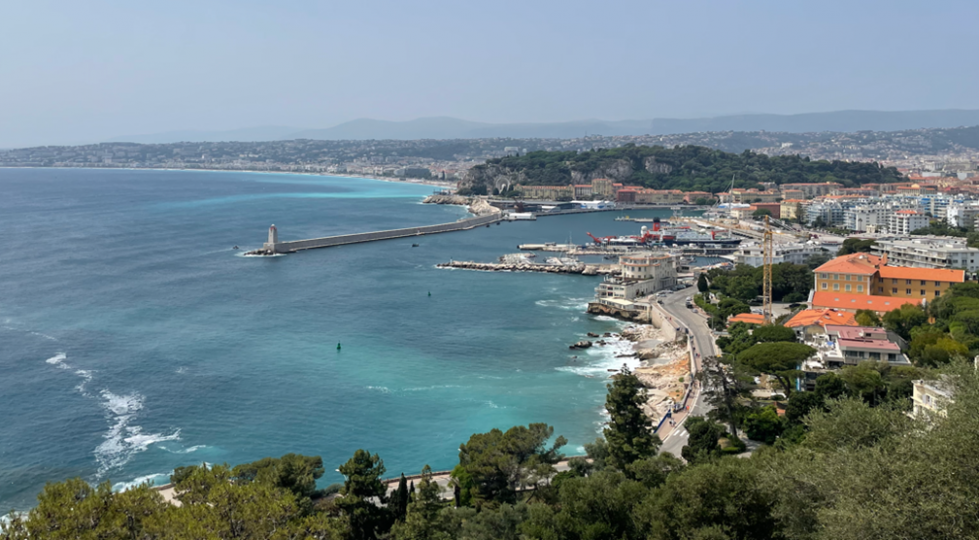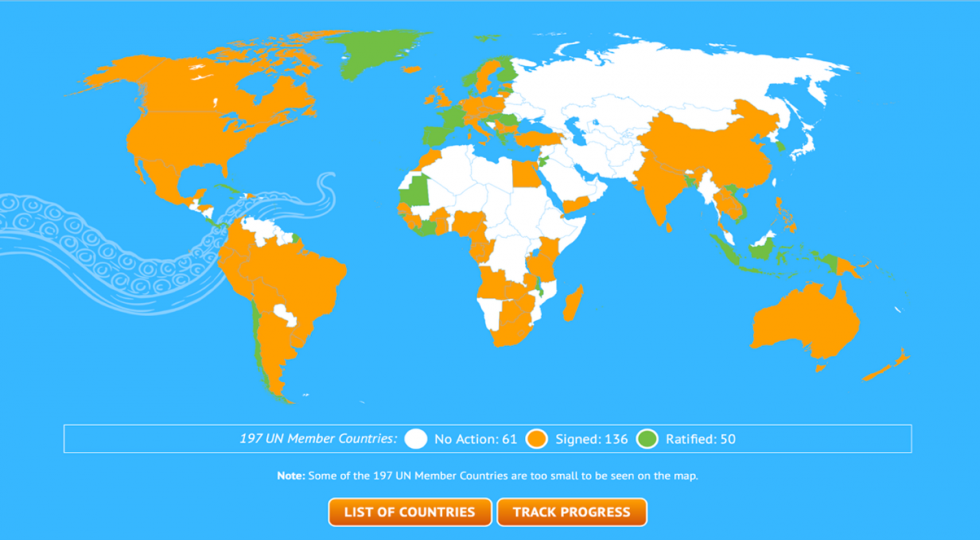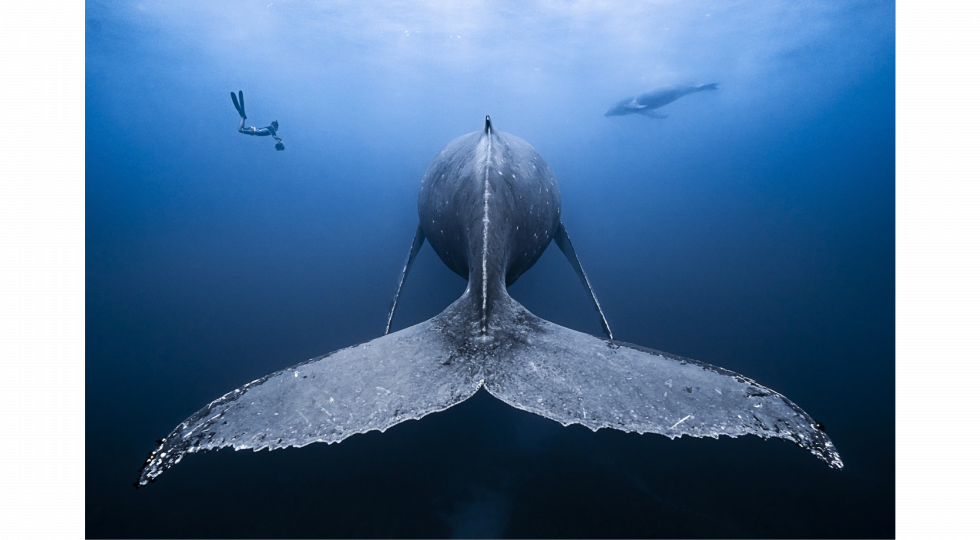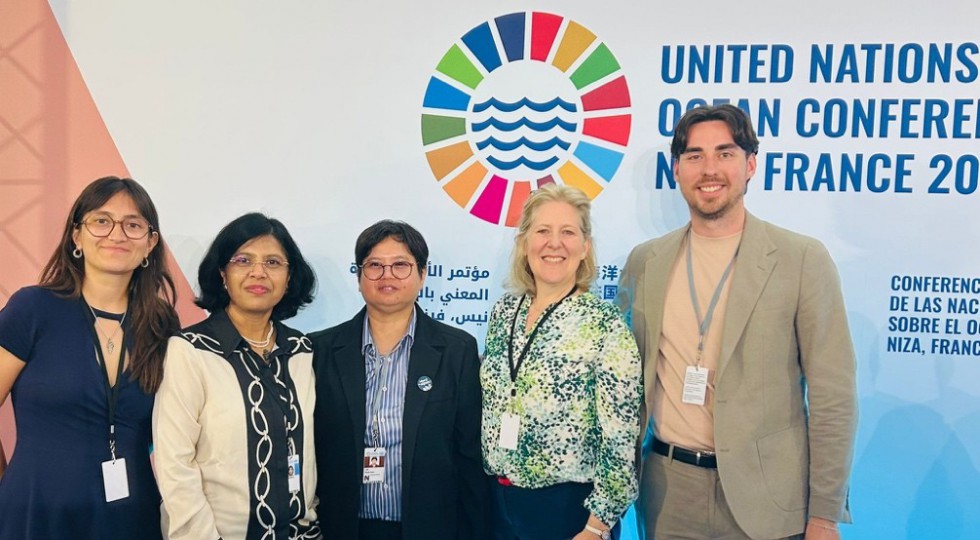Key Lessons and Gaps from the UN Ocean Conference (UNOC 3): My Reflections

Sil Katrien Maslov Lescrauwaet
09 July 2025 | #25.08 | The views expressed in this post are those of the author(s) and may not reflect those of UNU-CRIS.
As a young research intern at the United Nations University-CRIS working on seaweed aquaculture (policy) alongside the Global Seaweed SUPERSTAR project, I was unexpectedly in the privileged position to attend the UN Ocean Conference (UNOC3) firsthand in Nice. What I witnessed wasn’t just policy discussions or scientific presentations: it was a profound reckoning with how fundamentally skewed our understanding is of our relationship with the sea.

Figure 1. Coastal view of the city and port of Nice, France, showing the interface between urban development and the Mediterranean Sea. Photo by author, June 8, 2025.
Cheers erupted each time another country stepped forward to sign to ratify the Biodiversity Beyond National Jurisdiction Agreement, also known as the BBNJ Agreement, which is an agreement under the UN Convention on the Law of the Sea on the conservation and sustainable use of marine biologial diversity in areas beyond national jurisdiction. The BBNJ Agreement creates the first legally binding framework to protect mrine life in international waters, addressing a major governance gap in the two-thirds of ocean beyond national borders that small island states depend on for their survival and prosperity. In the signing ceremony hall, representatives from French Polynesia, the Maldives, and other small island developing states (SIDS) applauded with an intensity that cut through the diplomatic formalities. Their enthusiasm wasn’t ceremonial… It’s existential. For these nations and regions, their very existence hangs in the balance of ocean health, so every signature represents a lifeline. This moment crystallised the bitter – or should I say, salty? – irony that threaded through my experience at the UN Ocean Conference in Nice: SDG 14 Life Below Water is the least funded of all SDGs. With just below $10 billion invested between 2015 and 2017, recent reports suggest that $175 billion per year is actually needed to achieve SDG 14 by 2030. The ocean covers 71% of our planet and produces every second breath we take, yet it receives a fraction of the investment it desperately needs.

Figure 2. Treaty Ratification Progress Map, by High Seas Alliance. Retrieved June 24, 2025, from https://highseasalliance.org/treaty-ratification/map/.
The credit card we never ordered
Picture this: every year, it is said that you consume more or less the equivalent of an entire credit card in microplastics. Not metaphorically, but literally, that’s how much microplastics the average person now ingests annually. What other synthetic fragments would there then be making their way through my system? Think also of sargassum “crisis”. Due to our planetary crisis, these brown floating algae bloom and absorb toxins that pollute the ocean. But when reaching the shores, the decomposed sargassum re-releases all these toxins, harming and killing whole ecosystems, and causing great economic losses to regions relying on tourism. The ocean’s problems, it turns out, don’t stay in the ocean.
Or, put correctly, there are no ocean issues, only human problems. Every crisis we are currently attributing to the sea, from biodiversity loss to sea level rise to acidification, traces back to human decisions, human systems, and human failures. As put brilliantly during the closing session: just like the planet “Earth”, we consist of around the same percentage of water. We’re not that different from the waters that surround us at all.
The Whale’s Dilemma: Protection or Performance?
Numbers tell a story of good intentions going astray. Latin America has protected 26% of its marine areas, quite impressive compared to Europe’s 8,76%. But here’s the catch: only 2.8% of those protected areas have effective management systems. Is this an environmental theatre performed on a continental podium, a kind of protection that exists beautifully in script while biodiversity keeps declining and coral reefs bleach in the real world? This performance of protection might reflect something deeper, though. As one speaker provocatively argued, environmental laws aren’t actually designed to protect the environment. They’re designed to legitimise human development while providing the comforting illusion of care through mitigation strategies. Think, for example, of the required environmental impact assessments: we’ve created legal frameworks that allow us to destroy responsibly, to pollute conscientiously, to exploit sustainably.

Figure 3. Humpback whale tail, Reunion Island, by François Baelen / Ocean Image Bank.
Consider migrating whales, crossing dozens of jurisdictions on their journey. In one area, they’re protected (e.g., ships are required to adhere to a maximum speed to minimize collision); in another, it’s fair game for shipping traffic or industrial fishing. The whale doesn’t recognize our human boundaries, but our laws certainly don’t recognise the whale’s needs. This, I believe, is where the concept of marine regions (managed by VLIZ) becomes crucial, yet underexplored. How do we create governance structures that match the fluid, interconnected reality of ocean life? It’s a question that kept resurfacing in my mind when attending panels and discussions about ecocide laws: can we shed light on aspirational justice? It’s the gap between what we dream of achieving, and what our current systems can actually deliver.
Redefining Infrastructure: Seaweed as a Metaphor, Seaweed as a Response
Ten years: that’s how long the Sendai Framework for Disaster Risk Reduction 2015-2030 (Sendai Framework) has existed. Yet, little to no progress has been made in reducing various types of losses. This uncomfortable truth sparked my thinking about what “infrastructure” actually means. As speakers brilliantly implied, natural ecosystems like mangroves and coral reefs are essential natural infrastructure or shield to protect our coasts and coastal communities, it’s living assets that increase in value over time, unlike grey infrastructure that deteriorates over time. So, instead of treating nature as a passive and separate backdrop to human activity, we should start to recognise it as our critical partner in coastal resilience. Mitigation strategies shouldn’t create new problems; they should contribute to diverse, resilient livelihood systems that work with ocean rhythms rather than against them.
Highlighting the urgency of prioritising this perspective, the side event “Toward the creation of a UN Task Force on Seaweed: Elevating Ambition for a Sustainable Blue Economy”, organised by the Global Seaweed Coalition and co-chaired by the Minister of Blue Economy of Madagascar and the French Government, our work contributed to discussions that resulted in the announcement of a new UN Task Force on Seaweed (UNTFS). The UNFTS is the first intergovernmental framework to coordinate global seaweed policy and standards across multiple UN agencies and multistakeholder partnerships. This initiative represents a critical step toward filling the governance gap in a $17 billion industry that has grown rapidly without comprehensive international coordination, with formal UN establishment planned for 2026. In addition, during Action Panel 9 on sustainable aquatic food systems, speakers emphasised we have just “six harvest seasons” left to meet our global targets. Seaweed, a rapidly expanding sustainable food source, is also a form of natural infrastructure that embodies the transformation speakers were advocating for. Unlike extractive industries that depreciate marine ecosystems, seaweed farming creates and sustains life by sequestering carbon, providing sustainable livelihoods, and requiring no fresh water or fertiliser. The call is clear: bringing aquatic foods (sustainably!) from the margins to the mainstreams could be a pillar of planetary health and human well-being (and not just a niche solution for food insecurity). The Global Seaweed SUPERSTAR project represents exactly the kind of cross-sector collaboration the conference called for: bringing together research institutions, communities, and policymakers to scale solutions that address multiple challenges simultaneously.

Figure 4. Team colleagues of the Global Seaweed SUPERSTAR Project at the United Nations Ocean Conference (UNOC 3) in Nice, France, during their side event. The project advances discussions on sustainable seaweed aquaculture, climate resilience, and ocean-based responses to challenges. Photo by Nidhi Nagabhatla, June 13 2025.
Beyond Nice
According to many, UNOC3 was expected to be our “last best chance” to get SDG14 back on track, with expectations running high for the Nice Ocean Action Plan. The conference aimed to complete key ocean governance processes: from the BBNJ Agreement ratifications to finalising the WTO’s Fisheries Subsidies Agreement, while mobilising exponentially more finance for the sustainable blue economy. With only 8.3% of the ocean currently designated as a MPA, and a mere 2.8% effectively protected, the 30x30 target seemed both urgent and achievable.
Yet as I watch the SIDS representatives celebrate each treaty signature, I couldn’t help but think: shouldn’t we have been even more ambitious? The conference exceeded expectations in many ways, but imagine if we had closed UNOC3 with 60 countries having signed and ratified the BBNJ Agreement, not just the steady trickle we witnessed. Imagine if every nation had committed to concrete financing mechanisms for ocean protection, not just warm words about the blue economy’s potential.The gap between what was achieved and what was needed might also reflect something deeper than diplomatic caution: it reveals how we’ve normalised incremental progress on an exponential crisis. With less than 2% of international waters under protection, a biodiversity crisis while plastic accumulates, can we really afford to celebrate modest gains as victories?

Figure 5. Conference attendees observe a presentation emphasizing the connection between terrestrial actions and marine ecosystems during the UN Ocean Conference in Nice, France. Photo by Morgan Mathurin, June 2025.
The path from Nice back to Bruges (UNU-CRIS), to me, feels charged with new purpose, but also heavy with responsibility and ambition. Every mechanism we assess, every framework we develop, can contribute to closing that gap between aspirational justice and real change: between protection that exists beautifully in script, and protection that works alongside the communities who depend on these waters. The cheers from SIDS representatives carry a different weight. They remind us that behind every statistic, every framework, every policy proposal, there are real people whose futures depend on getting this right, and getting it right quickly. Because in the end, the ocean might not be the one who needs saving – we do. And recognising that difference, while acknowledging those who have always known it, might be the first step toward real change.
